![]()
![]()
![]()
Use LEFT and RIGHT arrow keys to navigate between flashcards;
Use UP and DOWN arrow keys to flip the card;
H to show hint;
A reads text to speech;
67 Cards in this Set
- Front
- Back
|
Introduced double helical model of DNA |
1953-James Watson and Francis crick Hereditary information is encoded in DNA and reproduced in all cells of the body |
|
|
DNA program directs the development of... |
Biochemical, anatomical, physiological, and to some extent behavioral traits |
|
|
DNA replication |
Cells can repair their DNA |
|
|
20th century the identification of the molecules of inheritance loomed as a major challenge by biologist |
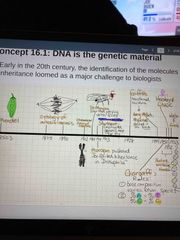
I |
|
|
The role of DNA in hereditary was first discovered by studying... |
Bacteria and the viruses that infect them |
|
|
Frederick Griffith 1928 |
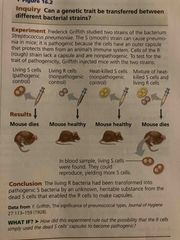
Studied 2 strains of bacteria: one pathogenic and one harmless When he mixed heat-killed remains of the pathogenic strain with living cells, some living cells became pathogenic Called this transformation |
|
|
Transformation |
Change in genotype and phenotype due to assimilation of foreign DNA |
|
|
Oswald Avery, Maclean McCarthy, and Colin Macleod |
Identified the transforming substance as DNA from griffiths work Many biologist were skeptical |
|
|
Additional Evidence of DNA |
DNA as genetic material came from studies of viruses that infect bacteria Bacteriophages or phages |
|
|
Bacteriophages or phages |
Bacteria eaters Often used in genetic research |
|
|
Virus |
DNA (sometimes RNA) enclosed by a protective coat, often a protein |
|
|
Alfred Hershey and Martha chase 1952 |
Showed that DNA is genetic material of a phage (T2) Designed experiment showing only one of the two components of T2 (DNA or protein) enters E.coli cell during infection Concluded injected DNA of the phage provides the genetic info |
|
|
DNA is a ———-each consisting of a... |
Palmetto of nucleotides Consisting of nitrogenous base, a sugar, and a phosphate group |
|
|
Erwin chargaff 1950 |
Reported that DNA composition varies from one species to the next Made evidence of DNA a more credible candidate for the genetic material Created chargoffs rules |
|
|
Chargaffs rules |
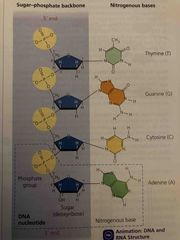
1. The base composition of DNA varies btw species 2. In any species the number of A=T and G=C The basis for these rules was not understood until the discovery of the double helix |
|
|
Rosalind Franklin and Wilkins |
A technique called X-ray crystallography to study molecular structure Produced image of DNA These images would be used to help deduce a DNA helical including width and spacing of the helix |
|
|
Double helix |
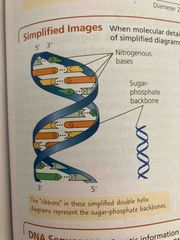
Two strands |
|
|
Franklin had already concluded that... |
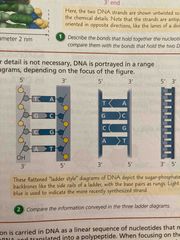
The 2 outer sugar phosphate backbones were on the outside The nitrogenous based paired in the molecular interior |
|
|
Antiparallel |
The backbones of DNA Their subunits run in opposite directions |
|
|
Pairing of DNA |
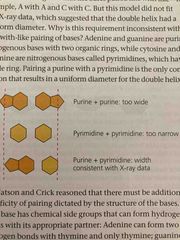
Thought paired like at first but due to width, realized must pair a purine with a pyrimidine to be uniform Pairing was more specific dictated by base structures |
|
|
A to the T pairing |
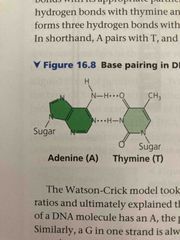
Adenine paired only with thymine due to its base Adenine is a purine with 2 organic rings Thymine is a pyrimidine with a single ring Adenine can form 2 hydrogen bonds with thymine and only thymine |
|
|
G to the C pairing |
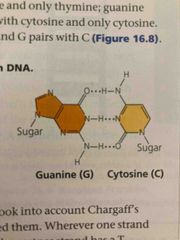
Gaunine is paired with cytosine Gaunine is a purine with 2 organic rings Cytosine is a pyrimidine with one ring Gaunine can form 3 hydrogen bonds with cytosine and only cytosine |
|
|
The chemistry of DNA structure |
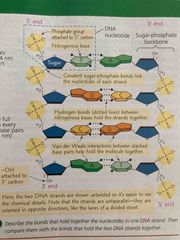
I |
|
|
Percentages according to chargaff |
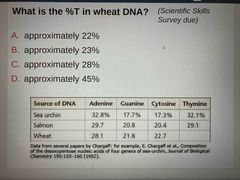
A and T will be the same percent G and C will be the same percent And they total 100 Answer is C |
|
|
Many ____ work together in DNA replication and repair |
Proteins |
|
|
DNA replication and repair |
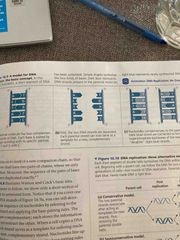
Specific base pairing suggested a possible copying mechanism for genetically material (Watson and crick) Parent molecule unwinds to form 2 daughter strands Each strand acts as a template for building a new strand |
|
|
Semiconservative model |
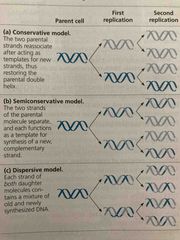
Watson and cricks model Conservative: parent molecule comes back together Disperse: each strand is a mix of new and old |
|
|
Matthew meselson and Franklin stahl experiments |
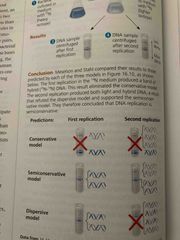
Supported semiconservative model Labeled nucleotides of the old strands with a heavy isotope of nitrogen New nucleotides were labeled with a lighter isotope |
|
|
The copying of DNA is remarkable in its speed and accuracy |
More than a dozen enzymes and other proteins participate in DNA replication |
|
|
Origins of replication |
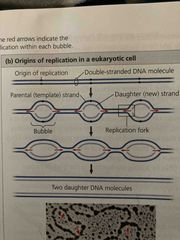
Site where 2 DNA strands are separated Open up like a bubble Where replication begins |
|
|
A eukaryotic cell may have—-origins of replication |
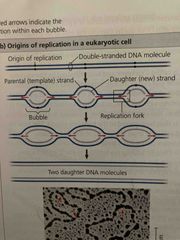
Hundreds to thousands Replication proceeds in both directions until the entire molecule is copied |
|
|
Replication fork |
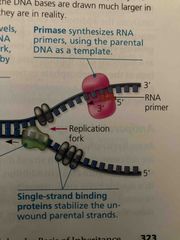
Y-shaped region where new DNA strands are elongated At the corners of each bubble Single-strand binding proteins bind to unpaired strands at the forks, keeping them from re-binding |
|
|
Helicases |
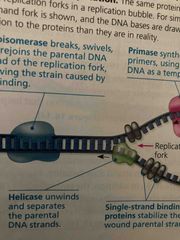
Enzymes that untwist the double helix at the replication forks Separate the two strands making them available as template strands |
|
|
Single-strand binding proteins |

Bind to unpaired strands and keep them from re-pairing Stabilize single strand |
|
|
Topoisomerase |
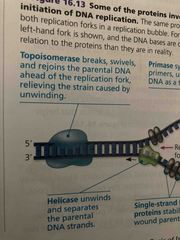
Relieves strain by breaking, swiveling, and rejoining DNA This strain is from untwisting of the double helix ahead of the replication fork |
|
|
DNA polymerases cannot initiate synthesis of a polynucleotide, they can only... |
Add nucleotides to an existing 3’ end which requires a primer (RNA) |
|
|
Primer |
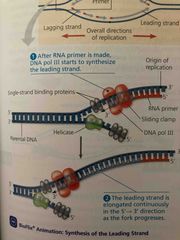
Initial nucleotide strand, Short RNA primer Synthesized by enzyme primase Short-5 to 10 nucleotides long 3’ end serves at starting point for new DNA strand |
|
|
Primase |
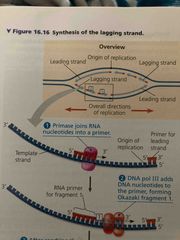
Enzyme Starts RNA chain from scratch and adds RNA nucleotides one at a time using parents DNA template |
|
|
DNA polymerases |
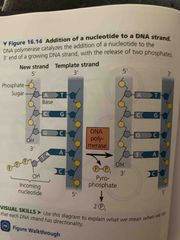
Enzymes that Catalyze the synthesis of new DNA at a replication fork Most require a primer and a DNA template strand Polymerases catalyzes the addition of each monomer via a dehydration reaction ( as each is joined, 2 phosphates groups are lost) |
|
|
Rate of elongation for bacteria and human cells... |
Bacteria: 500 nucleotides per second Human cells: 50 nucleotides per second |
|
|
Chemical reactions of nucleotides |
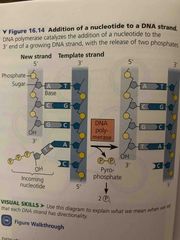
Each added to strand is a nucleoside triphisphate (dATP) Supplies adenine to DNA like ATP in metabolism As each monomer joins DNA strand, via dehydration reaction, it loses 2 phosphate groups (pyrophosphate) Hydrolysis of the phosphate intermediate is coupled exergonic reaction that drives the polymerization reaction |
|
|
Antiparallel elongation |
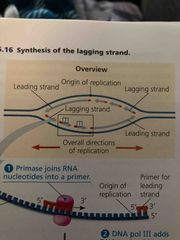
The antiparallel structure of double helix affects replication DNA polymerases add nucleotides only to the free 3’ end of a growing strand Therefore a new strand can elongate only in a 5’ to 3’ direction |
|
|
Leading strand |
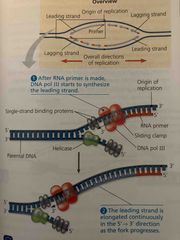
DNA polymerase synthesizes along one template strand of DNA continuously Moves toward the replication fork |
|
|
Lagging strand |
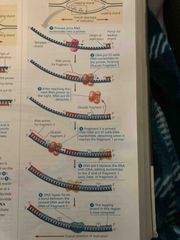
Elongating the other new strand DNA polymerase works in the direction away from the fork Synthesized in a series of segments (Okazaki) |
|
|
Okazaki fragments |
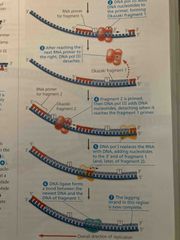
Lagging strand is synthesized in fragments These are joined together by DNA ligase |
|
|
The proteins that participate in DNA replication form a large complex called... |
A DNA replication machine Machine may be stationary during replication process Some studies show a “reel in” process but exact mechanism is known and could vary in different species |
|
|
Proofreading and repairing DNA |
DNA polymerase proofread newly made DNA Replacing any incorrect nucleotides Mismatch repair |
|
|
Mismatch repair |
Other enzymes remove and replace incorrectly paired nucleotides that have resulted from replication errors A hereditary defect in one repair enzymes can result in colon cancer |
|
|
Nucleotide excision repair |
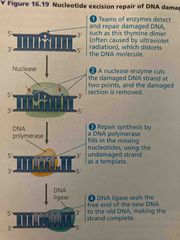
Cuts out and replaces damaged DNA DNA can be damaged by chemicals or physical agents (cigarette smoke, X-rays) and undergo spontaneous changes |
|
|
Evolutionary significance of altered DNA nucleotides |
Error after proofreading and repair is low, but not zero Sequence changes may become permanent and can be passed on These changes (mutations) are the source of genetic variation With natural selection, new appearances of species prevails |
|
|
Limitations of DNA polymerase create problems for the linear DNA of eukaryotic chromosomes |
No way to complete the 5’ ends (where there is an RNA primer) Repeated rounds of replication produce shorter DNA molecules with uneven ends |
|
|
Replicating ends of DNA is not a problem for prokaryotes because |
Most have circular chromosomes |
|
|
Telomeres |
Special nucleotide sequences at the end of eukaryotic DNA molecules Do not prevent shortening of DNA molecules, but postpone erosion of genes near ends of DNA molecules |
|
|
Shortening of telomeres is connected to |
Aging |
|
|
Telomerase |
Catalyzes the lengthening of telomeres in germ cells If they became shorter in every cycle, genes would be missing from the gametes |
|
|
Cancer and telomeres |
Shortening of telomeres may protect cells from cancerous growth by limiting the number of cell divisions Evidence of telomerase activity in cancer cells which may allow cancer cells to persist |
|
|
A double stranded circular DNA molecule... |
Bacterial chromosome Associated with a small amount of protein Supercooled and found in the nucleoid |
|
|
Linear DNA molecules... |
Eukaryotic chromosomes Associated with large amount of protein |
|
|
Chromatin |
A complex of DNA combined with proteins |
|
|
Histones |
Proteins responsible for first level of packing in chromatin in nucleus Multilevel system of packing in nucleus |
|
|
Nucleosome |

Basic unit of DNA packaging, looks like a bead Unfolded chromatin, composed of 2 each of the 4 basic histone types (dna wrapped twice around the core of the 8) N-termini tails of histones protrude from nucleosome
|
|
|
Involved in gene expression... |
Nucleosomes and their histone tails |
|
|
Chromatin undergoes changes in packing during... |
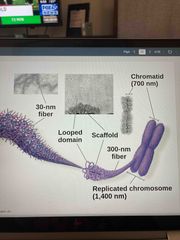
Cell cycle and gene expression At interphase: some chromatin organized in 10 nm fiber, but most is 30 nm fiber (folding and looping) Chromosomes occupy specific restricted regions in nucleus Fibers of different chromosomes does not become entangled (not like a bow of spaghetti ) |
|
|
Most chromatin is ____ in nucleus and becomes _____prior to mitosis |
Loosely packed in nucleus Condensed prior to mitosis |
|
|
Euchromatin |
Loosely packed chromatin |
|
|
Heterochromatin |
Regions of chromosomes (centromeres and telomeres) are highly condensed Dense packing makes it difficult for the cell to express genetic information coded in these regions |
|
|
Histones can undergo chemical modifications that result in changes in |
Chromatin condensation These changes can also have multiple effects on gene expression |

